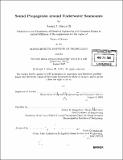| dc.contributor.advisor | Arthur B. Baggeroer. | en_US |
| dc.contributor.author | Sikora, Joseph J., III | en_US |
| dc.contributor.other | Massachusetts Institute of Technology. Dept. of Electrical Engineering and Computer Science. | en_US |
| dc.date.accessioned | 2007-10-19T20:29:17Z | |
| dc.date.available | 2007-10-19T20:29:17Z | |
| dc.date.copyright | 2005 | en_US |
| dc.date.issued | 2005 | en_US |
| dc.identifier.uri | http://hdl.handle.net/1721.1/39196 | |
| dc.description | Thesis (S.M.)--Joint Program in Applied Ocean Science and Engineering (Massachusetts Institute of Technology, Dept. of Electrical Engineering and Computer Science; and the Woods Hole Oceanographic Institution), 2005. | en_US |
| dc.description | Includes bibliographical references (leaves 120-121). | en_US |
| dc.description.abstract | This thesis develops and utilizes a method for analyzing data from the North Pacific Acoustic Laboratory's (NPAL) Basin Acoustic Seamount Scattering Experiment (BASSEX). BASSEX was designed to provide data to support the development of analytical techniques and methods which improve the understanding of sound propagation around underwater seamounts. The depth-dependent sound velocity profile of typical ocean waveguides force sound to travel in convergence zones about a minimum sound speed depth. This ducted nature of the ocean makes modeling the acoustic field around seamounts particularly challenging, compared to an isovelocity medium. The conical shape of seamounts also adds to the complexity of the scatter field. It is important to the U.S. Navy to understand how sound is diffracted around this type of topographic feature. Underwater seamounts can be used to conceal submarines by absorbing and scattering the sound they emit. BASSEX measurements have characterized the size and shape of the forward scatter field around the Kermit-Roosevelt Seamount in the Pacific Ocean. Kermit-Roosevelt is a large, conical seamount which shoals close to the minimum sound speed depth, making it ideal for study. Acoustic sources, including M-sequence and linear frequency-modulated sources, were stationed around the seamount at megameter ranges. A hydrophone array was towed around the seamount to locations which allowed measurement of the perturbation zone. Results from the method developed in this thesis show that the size and shape of the perturbation zone measured coincides with theoretical and experimental results derived in previous work. | en_US |
| dc.description.statementofresponsibility | by Joseph J. Sikora, III. | en_US |
| dc.format.extent | 121 leaves | en_US |
| dc.language.iso | eng | en_US |
| dc.publisher | Massachusetts Institute of Technology | en_US |
| dc.rights | M.I.T. theses are protected by copyright. They may be viewed from this source for any purpose, but reproduction or distribution in any format is prohibited without written permission. See provided URL for inquiries about permission. | en_US |
| dc.rights.uri | http://dspace.mit.edu/handle/1721.1/7582 | |
| dc.subject | Joint Program in Applied Ocean Science and Engineering. | en_US |
| dc.subject | Woods Hole Oceanographic Institution. | en_US |
| dc.subject | Electrical Engineering and Computer Science. | en_US |
| dc.subject.lcsh | Underwater acoustics | en_US |
| dc.subject.lcsh | Seamounts | en_US |
| dc.title | Sound propagation around underwater seamounts | en_US |
| dc.type | Thesis | en_US |
| dc.description.degree | S.M. | en_US |
| dc.contributor.department | Joint Program in Applied Ocean Physics and Engineering | en_US |
| dc.contributor.department | Woods Hole Oceanographic Institution | en_US |
| dc.contributor.department | Massachusetts Institute of Technology. Department of Electrical Engineering and Computer Science | |
| dc.identifier.oclc | 70124623 | en_US |
